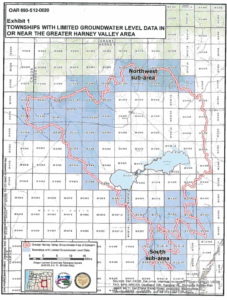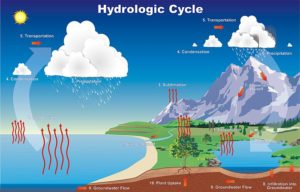New: Harney Valley Groundwater Area of Concern


The Oregon Water Resources Commission’s (OWRC’s) rulemaking for the Greater Harney Valley Groundwater Area of Concern (Area of Concern) became effective on April 15, 2016. The new regulations limit pending and new applications for groundwater use in the Malheur Basin. Citing concern over lowering groundwater levels in the region, OWRC passed the new regulations to limit new water development until the Oregon Water Resources Department (OWRD) can adequately study the basin’s groundwater. This regulation is a component of the Malheur Basin Program. The drafts, maps, and rules are available at: http://www.oregon.gov/owrd/Pages/law/Department_Rulemaking.aspx.
Over a year ago, OWRD stopped issuing new ground water permits within the Area of Concern. Until the most recent rulemaking, however, no rules were in place allowing OWRD to halt permit processing and issuance. Usually, OWRC will create by rule Critical Groundwater Areas, Groundwater Limited Areas, and Serious Water Management Problem Areas prior to OWRD ceasing to issue new permits.
OWRC can designate Critical Groundwater Areas for multiple reasons, including declining groundwater levels, substantial interference between wells, overdraft of groundwater, or water quality degradation. OWRD must indicate the boundaries of the area and review the designation at least every 10 years. The designation allows OWRD to, for example, close the area to any further appropriation, limit the total withdrawal from the aquifer, and refuse applications for new groundwater permits.
Groundwater Limited Areas limit future appropriations of water to specified uses, but do not restrict existing consumption of water within the area. Serious Water Management Problem Areas allow OWRD to collect usage data from current water use right holders, but not restrict water consumption. These tools are used to collect information and guide future development of water resources in Oregon.
Rather than designating a critical or limited groundwater area, or a serious water management problem area, OWRD addressed the Harney Valley Groundwater Area of Concern by amending the Malheur Basin Program. Basin programs are used by OWRC to guide water right permitting decisions and coordinate with other state agencies. Within basin plans, OWRC may classify the highest and best uses for particular basins and waterways for future uses, including proscribing types of uses available to future applicants. Oregon’s basin programs are listed in the Oregon Administrative Rules Chapter 690, beginning at Division 500, and the Malheur Basin Program is located at Division 510, available at: http://arcweb.sos.state.or.us/pages/rules/oars_600/oar_690/690_510.html.
The new regulations for the Greater Harney Valley Groundwater Area of Concern propose to both limit future uses and collect information before OWRD completes a full study of the aquifer, expected to be completed by 2020. The proposed rules received 22 comments, which can be viewed at: http://apps.wrd.state.or.us/apps/misc/vault/vault.aspx?Type=WrdNotice¬ice_item_id=6640. In the meantime, 39 groundwater use applications are pending before OWRD, and these applications will not be approved, unless they meet conditions included in the new basin plan regulations. This is in direct opposition to the rule that applications must be processed based on the laws and regulations in effect at the time of filing, but OWRD is taking the position that groundwater is not available for the applications, rather than a regulatory change affected the outcome of the applications (this is not a new approach from OWRD).
The “area of concern” is, in effect, a moratorium on new groundwater development in the region. The new regulations create restrictions on new applications reminiscent of critical groundwater areas, but within the basin program scheme. The moratorium will put a halt to development in the region, at least while OWRD studies the groundwater in the area. Locals familiar with groundwater in the Malheur Basin are resentful of OWRD’s blanket moratorium when certain areas within the basin do not appear to show the same level of strain as others, and continue to produce great quantities of groundwater.
Make sure to stay tuned to Schroeder Law Offices’ Water Blog for more news that may affect you!
This article was drafted with the assistance of Law Clerk Jakob Wiley, a concurrent student at Oregon State University’s Water Resources Policy and Management graduate program and a law student at the University of Oregon School of Law.

